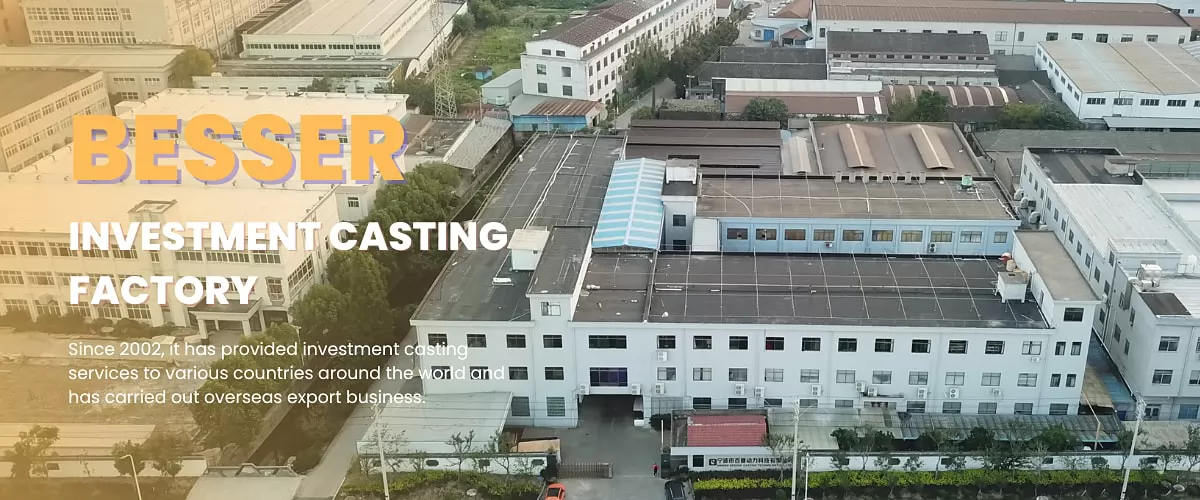
All walks of life have different requirements for precision castings. In order to meet the needs, precision casting technology shows its wide adaptability, such as the diversity of materials, the complexity of shapes, the batch of production, the accuracy of dimensions, In terms of uniformity, stability and surface accuracy, there are new advances and improvements in these properties today.
1. Wax
Wax is the first link in the production of precision casting. As we all know, due to the development of casting production, the requirements for wax materials are correspondingly varied. The easiest way for producers is to choose from commercially available wax materials, they can prepare them themselves, or they can entrust professional factories to produce them as required.
But no matter what kind of wax material, its required properties are the same, namely: melting point, freezing point, softening point, thermal conductivity, fluidity, shrinkage, shrinkage, strength, hardness, toughness, release, coating and hanging, Recyclability, dimensional stability and residual ash content after high temperature burning, etc.
Based on the production of specific castings, we choose a wax material, which requires the wax material to have characteristics in certain aspects, primary and secondary; at the same time, it is also an important factor to consider the cost.
In order to meet the specific requirements of various castings, waxes are divided into liquid, semi-liquid, semi-solid, solid; filled and unfilled; water-soluble and water-insoluble; regenerated and non-regenerated; wax Moulding, casting system, bonding, repairing, sealing, resin wax, etc. As far as wax materials for wax models are concerned, there are also many varieties, and they are continuing to develop.
Filler wax (FILLER WAX) is widely used, and the commonly used fillers are powdered polyethylene, polystyrene, organic acid, fatty acid, and starch. The added amount is 30% to 45% of the total amount. This kind of wax material has good thermal insulation, that is, it can be formed at a lower temperature, its fluidity is good, and the details of the wax mold can be clearly reproduced.
Styrene, adding isophthalic acid and adding three kinds of wax materials with trade name P2 FILLER, the time from 104 ℃ to 49 ℃ were 59 seconds, 62 seconds, and 99 seconds respectively, which shows that the type of filler is suitable for The influence of wax properties is greater.
The shrinkage of this type of wax material is more than 5% smaller than that of the unfilled material. A problem closely related to the properties of wax materials is the influence of the preparation, use, and processing methods of wax materials on the properties of wax materials.
1. Prevent the wax from overheating during the melting process
(1) Use an indirectly heated oil bath furnace and force the heat transfer oil to circulate. The melting temperature is controlled within the range of 84-98 °C, and it is always in a state of agitation. It also has the effect of preventing precipitation.
Excessive temperature and local overheating will deteriorate the performance of the wax due to oxidation and carbonization of the wax. The performance of overheating is that the color of the wax changes, the inner wall of the wax bucket produces black spots, it is translucent due to the separation of the filler, and the smoke or evaporation is generated in the wax bucket.
(2) In order to remove impurities and moisture, the wax must be heated to above the melting point of the wax, usually controlled below 120 °C, in order to ensure that the wax has a certain flow ability to remove impurities, and its moisture content is also It will evaporate with the agitation of the stirrer.
(3) For the wax pressed rod used under the heat preservation of the heat preservation cylinder, the heating temperature only needs to be 2-3 ℃ higher than the injection temperature.
(4) When the wax is removed in the autoclave (pressure tank), the steam temperature can be as high as 150 °C or more. This condition is the main link that causes the performance of the wax to deteriorate. Therefore, try to reduce the dewaxing temperature and dewaxing pressure. to maintain the properties of the wax.
2. Keep the ambient temperature
In the wax mold manufacturing room, whether it is winter or summer, the indoor temperature should be kept within 20-25, so that the size of the wax mold is in a stable environment, and at the same time, it is matched with the environmental conditions of the pulping and shell making process to ensure the quality of the shell.
(1), heating and heat preservation of wax material
The wax material enters the molding from the wax bucket under pressure, and cools and solidifies in the molding. In this process, the temperature difference is the main factor affecting the shape, size and stability of the wax pattern. Therefore, the uniformity of the temperature of the wax barrel is extremely important when using the wax barrel to keep the wax material in the wax. of wax buckets cannot produce sound wax patterns.
For this reason, the wax barrel is usually heated and kept warm by a heat preservation tank, and the heat preservation tank can usually be set within 58-62 °C, which is slightly higher than the injection temperature. In a longer time, at least 8 hours after heating and homogenization can be used.
The heat preservation tank is an oil bath heating device. The heat transfer oil circulates under the pressure of the oil pump, so that the wax barrel is heated and kept warm at a uniform temperature. The temperature controller of the heat preservation tank can set the required temperature according to the needs. When the wax barrel with uneven temperature is pressed, the wax mold will have defects such as full filling, cold insulation, granular surface, flow pattern and mesh pattern.
(2), the forming method of wax mold
Different forming methods are produced according to the size, shape and technical requirements of the casting. And different forming methods have different wax materials to match.
From the power of pressing wax, there are manual, electric, pneumatic, hydraulic, etc.; from the pressure, there are low pressure, medium pressure, high pressure, etc.; from the wax state, there are liquid, semi-liquid, semi-solid, solid, etc.; from the pressure Types include metal type, rubber type, plaster type, etc. From castings, there are industrial products, works of art, etc.
2. Wax Pattern Defects
Due to various reasons, the wax mold produced by the wax pressing machine will have some defects, mainly including the following:
1. Full of dissatisfaction
The main reason is that the temperature of the wax material is low, the injection speed is slow, and the pressing temperature is low, which causes the wax material to cool quickly during the flow process, which is manifested in the corners and edges or the thin-walled part of the wax mold. Rounded corners appear, similar to underpouring of metal castings.
2. Bubbles
One is the surface bubbles, that is, the subcutaneous bubbles visible to the naked eye, with individual distribution and dense distribution; the other is the bubbles in the deep layer of the wax mold, usually concentrated and larger bubbles, which cannot be seen by the naked eye, but can be seen from the wax. The local bulge of the mold, which appears in the central part of the wax mold and the last cooled part, is the result of the release of the internal pressure and the expansion of the gas.
3. Surface wrinkles
Due to insufficient wax temperature, low injection speed, improper coordination of wax movement and molding temperature; or due to damage or uncleanness of the inner surface of the molding; improper placement of the chilled metal block, etc., leaving motion on the surface of the wax mold Mark of. Deep texture, similar to cold insulation defects in metal castings; slight wrinkles can be removed by grinding. In addition, around the core and around the holes, sometimes there are seams, which are slightly concave. In fact, the meeting of the two wax streams is not well fused, which is the result of insufficient temperature and pressure of the wax material.
4. Rough surface
Because the injection pressure is too small or the injection speed is not enough, the contact density between the wax material and the inner surface of the molding is not enough, and the surface state of the molding cannot be faithfully reflected, and there are serious wrinkles.
5. Shrinkage
The surface of the wax mold is concave, mainly because the injection pressure and time are not enough, or the temperature of the wax material is high, the cooling time is not enough, and sometimes there is too much release agent, which may also reduce the properties of the wax material. Surface shrinkage involves a large area and is difficult to repair.
6. Deformation
After the wax mold is removed from the molding, in addition to the shrinkage and changes in size, it is artificially deformed due to improper removal techniques; it is common for the wax mold to be flexed due to changes in the temperature field due to the cooling of the wax mold. Therefore, the wax model just taken out from the pressing should still be placed carefully. Usually, it is flat based on a larger plane. If necessary, a shape suitable for the deformed part is used to make a metal block embedded in the wax model to prevent deformation. cool down. It is also possible that the wax material is too soft, the molding components are not suitable, etc.
7. Hairy wings (shackles)
This is one of the most common defects, that is, a thin wax piece escapes at the compressing part, the junction of the compressing block, the connection between the core and the core seat, etc. The main reasons for this are insufficient molding accuracy, the molding parting surface or the joint surface of the inner parts of the molding is damaged or adhered to dirty objects, or the molding force is not enough, and the injection pressure is too high. Or the temperature of the wax is too high. The fins must be completely removed before the wax model can be used.
8. Adhesion
The adhesion of the wax mold to the mold is caused by the lack of release agent, or the temperature of the wax and the mold is too high, or the mold is damaged and the mold is not clean.
Conclusion

Wax mold manufacturing is the same as subsequent assembly, shell making, dewaxing, pouring, and cleaning. The importance of the operation process should be emphasized. The cooperation between each link must be carried out. Process cards and related technical management documents for each process must be implemented.
We are a professional investment casting company, specializing in providing and customizing various precision metal casting services for foreign and overseas customers. If your project requires metal casting services, please contact us. We will give a reasonable solution!



